Narrative family therapy sarah nondo presentation.pptx
Download as PPTX, PDF0 likes129 views
psychology
1 of 13
Download to read offline
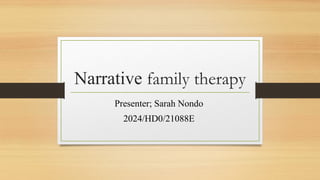
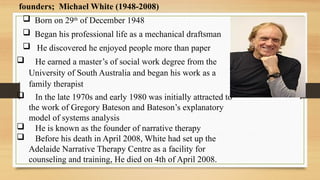
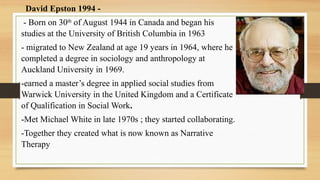




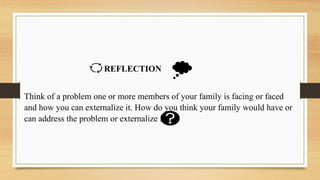

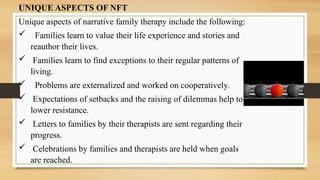
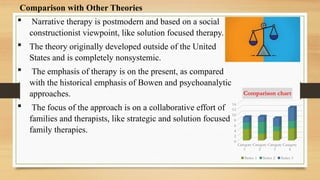

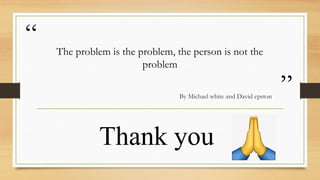
Ad
Recommended
Lecture 8 narrative therapy
Lecture 8 narrative therapyNewham College University Centre Stratford Newham
╠²
This document provides an introduction and overview of narrative therapy. It begins by outlining the key learning outcomes, which include identifying background influences of narrative therapy, describing its core concepts, and examining the conceptualization of problems, therapeutic goals, the therapist's role, and interventions used. The core concepts are then defined, such as the view that realities are socially constructed and problems should be externalized. Therapeutic techniques like questioning, externalization, and creating alternative stories are also reviewed. Finally, the evaluation addresses narrative therapy's contributions and limitations.Narrative approach
Narrative approachSWATHY M.A
╠²
The narrative approach focuses on separating the individual from their problems through storytelling. It believes that by externalizing problems, individuals can be empowered to overcome destructive behaviors. The therapist acts as a facilitator who uses questioning to help clients construct alternative stories that reduce the influence of problems on their lives. Some key aspects of narrative therapy include viewing the client as the expert, being non-blaming, and discovering unique outcomes or moments when clients were not dominated by problems. The goal is to invite people to describe their experiences in new, problem-free languages and view problems as things people have rather than things people are.NARRATIVE.pptx
NARRATIVE.pptxEnametse Kudumane
╠²
Narrative therapy, developed by Michael White and David Epston in the 1980s, emphasizes a non-blaming approach that positions clients as experts in their own lives and seeks to separate problems from personal identity. The therapy employs techniques such as externalization, re-authoring stories, and exploring unique outcomes to help clients construct alternative narratives and redefine their experiences. This approach contrasts with cognitive behavioral therapy by focusing on the narrative of a personŌĆÖs life rather than merely addressing negative thought patterns.NARRATIVE THERAPY Edited by KIM-FINAL
NARRATIVE THERAPY Edited by KIM-FINALKim Talia Pillay
╠²
Narrative therapy views problems as separate from clients and aims to help clients reauthor their life stories. It was developed in the 1970s by Michael White and David Epston who were influenced by postmodern philosophy and sought to move beyond traditional models of therapy. Key concepts in narrative therapy include externalizing problems so clients are not defined by them, deconstructing dominant stories, and collaboratively creating alternative narratives through therapeutic conversations. While established, more research is still needed to quantify narrative therapy's effectiveness.Narrative Therapy
Narrative Therapy Claudia L
╠²
This document provides an overview of narrative therapy, including its origins in the 1990s with Michael White, its key theoretical concepts, techniques used in therapy, and the role of the therapist. Some main points covered include externalizing problems so clients are not defined by them, helping clients generate alternative stories, using questions to facilitate new perspectives, and viewing clients as experts in their own lives who can overcome challenges.Narrative therapy-Post modern approach in counselling
Narrative therapy-Post modern approach in counsellinginfomixbagproduction
╠²
Postmodern approaches in counseling, particularly narrative therapy, focus on the subjective experiences of individuals rather than objective realities. Narrative therapy, developed by Michael White and David Epston, enables clients to reframe their life stories, externalize problems, and construct empowering narratives to redefine their identities. This method is effective for addressing trauma, depression, family issues, and self-esteem by facilitating insight and collaboration among clients and their support systems.Volume 39 n um ber 2a pril 2017pages i l6 l3 ld o iio .i
Volume 39 n um ber 2a pril 2017pages i l6 l3 ld o iio .iojas18
╠²
This article provides an introduction to narrative family therapy techniques. It discusses the theoretical foundations of systems theory and social constructionism that influence this approach. The article then illustrates various NFT techniques through a case study, such as eliciting family stories, externalizing problems, and reauthoring narratives. It concludes by recommending further development of competence in NFT.Narrative Therapy
Narrative TherapyJing Cuerdo
╠²
Narrative therapy, developed by Michael White and David Epston, emphasizes that a person's identity is shaped by their experiences and narratives, viewing problems as separate from the individual. The therapy aims to help clients articulate their experiences in fresh language, fostering collaboration and reflection while allowing clients to redefine their life stories. Techniques include externalizing problems, deconstructing issues to make them manageable, and focusing on unique outcomes to shift negative narratives into positive ones.Narrative Therapy
Narrative Therapyguest07f844
╠²
Narrative therapy uses stories to help clients understand problems in their lives. The therapist acts as a facilitator who listens without judgment and asks questions to help the client describe their experience in new ways. By exploring exceptions, unique outcomes, and alternative stories, the therapist helps the client "reauthor" their story in a way that opens up new possibilities for the future rather than being defined by past problems. The goal is for the client to see themselves as the expert of their own life rather than being dominated by problems.Narrative psychotherapy with couples 121614
Narrative psychotherapy with couples 121614Gladys Escalante
╠²
Narrative therapy focuses on externalizing problems rather than internalizing them in clients. Therapists help clients develop alternative stories and new narratives by asking questions, exploring exceptions, and collaborating to reauthor their life stories in a preferred direction. The goal is to guide clients to see themselves as competent and separate from problems, and to envision new possibilities rather than being defined by problem-saturated stories from the past.Lecture 1 introduction to systemic therapy
Lecture 1 introduction to systemic therapyNewham College University Centre Stratford Newham
╠²
This document provides an overview of the history and development of systemic family therapy. It discusses how the field shifted from a modernist to post-modernist perspective. Originally, problems were seen as arising from dysfunctional family relationships and communication patterns, viewing the self as relational. Later approaches emphasized narrative and social constructionism, examining how meaning is constructed through language. Family therapy incorporated ideas from cybernetics, systems theory, and postmodern concepts like pluralism and contextual truth.NARRATIVE THEORY - MICHAEL WHITE
NARRATIVE THEORY - MICHAEL WHITEzatul ayuni
╠²
This document provides an overview of Narrative Therapy theory and practices. It discusses the origins and key concepts of the theory, which was developed by Michael White and David Epston. Some of the core beliefs of Narrative Therapy are that the client is the expert of their own life, problems are separate from the client's identity, and therapeutic change occurs when the client takes control of their own story. The document outlines the therapeutic process and techniques used in Narrative Therapy, including externalization, searching for unique outcomes, and reauthoring alternative stories. It also discusses the strengths and limitations of the theory.Cross country baltimore part 1
Cross country baltimore part 1Terry Ledford
╠²
This document summarizes Terry L. Ledford's presentation on using therapeutic stories and metaphors to convey cognitive behavioral therapy principles for overcoming negative self-esteem. The presentation reviews principles of cognitive therapy and schema therapy, provides examples of helpful stories, and allows participants to practice developing therapeutic stories and metaphors in small groups. Ledford has developed various programs and publications that incorporate storytelling to address dysfunctional schema and improve self-esteem.Family Therapy: Forget The Blame Game And Solve Conflicts Together
Family Therapy: Forget The Blame Game And Solve Conflicts TogetherHHC Centre
╠²
Family therapy is a type of psychotherapy aimed at resolving conflicts within family units through improved communication and understanding among members. The process typically involves individual and group sessions led by a trained therapist, focusing on various approaches such as structural, strategic, narrative, transgenerational, communication therapy, reframing, psychoeducation, and relationship counseling. The main goal is to empower families to work through issues collaboratively, avoid the blame game, and develop healthier relationships.Report on system of family
Report on system of familyJessica Diezmo
╠²
The document discusses three major approaches to family therapy: structural family therapy developed by Salvador Minuchin which focuses on changing family structures and boundaries, strategic family therapy developed by Jay Haley which uses problem-focused directives to create behavioral change, and social constructionism therapy which emphasizes empowering family members through questioning and helping them develop alternative narratives and meanings of problems.1 family system therapy powerpoint presentation christine moran
1 family system therapy powerpoint presentation christine moranchristinemoran54
╠²
Family systems therapy views individuals as best understood through their interactions within the entire family. Symptoms are seen as expressions of family dysfunction, and problematic behaviors often serve purposes for the family system. The goals of family systems therapy are to change interactional patterns within the family and between generations to reduce distress and initiate family reorientation.Narriative Couples Therapy
Narriative Couples TherapyClaudia L
╠²
Narrative couples therapy developed in the 1990s by Michael White and David Epston. It is based on a social constructionist view that focuses on clients' experiences and meanings rather than pathological labels. The therapist takes a curious and collaborative approach to help clients explore alternative stories and develop new, more satisfying narratives about their relationship. Typical interventions include externalizing problems, highlighting unique outcomes, developing a history of the present, and having clients witness each other's stories. Through retelling and living out new multi-storied narratives, clients can change how they perceive themselves and their relationship.Narrative Therapy by Michael White & David Epston
Narrative Therapy by Michael White & David EpstonPrateek Sharma
╠²
The document discusses narrative therapy as a respectful, non-blaming counseling approach that emphasizes people as the experts in their own lives and seeks to separate problems from individuals. It outlines key features of narrative therapy, including externalization, re-authoring, and mapping influences, while examining the importance of storytelling in personal agency and healing. Additionally, it provides case examples demonstrating how narrative therapy can help individuals identify alternative stories and regain agency in their lives, ultimately enhancing their well-being.c h a p t e r 1Learning OutcOmesŌÖ”ŌÖ” Describe the circums.docx
c h a p t e r 1Learning OutcOmesŌÖ”ŌÖ” Describe the circums.docxbartholomeocoombs
╠²
The document explores the origins and evolution of family therapy, detailing the shift from individual-focused treatment to a systemic perspective involving families as key players in therapeutic progress. It highlights key pioneers and their theories, discussing early perceptions of families, the challenges therapists faced, and the application of group dynamics to family therapy. The chapter underscores the complex interplay of family roles and relationships in the therapeutic process, revealing how early family therapy practices emerged from a context of recognizing familial influence on individual mental health.Narrative Theory 2011
Narrative Theory 2011Teresa Miller
╠²
This document discusses the principles of narrative therapy. It states that people make meaning and understand themselves through the stories they hear and tell. Problems are shaped by social and cultural contexts rather than being inherent to the individual. The narrative therapist acts as a facilitator who helps clients develop new insights and empowerment by drawing attention to subtle changes, allowing clients to become authors of their own lives. Therapists are supportive and non-judgmental, focusing on eliciting strengths and alternative viewpoints rather than fixing problems.Narrativerevised2 110213204018-phpapp01
Narrativerevised2 110213204018-phpapp01lukavin
╠²
This document discusses the principles of narrative therapy. It states that people make meaning and understand themselves through the stories they hear and tell. Problems are shaped by social and cultural contexts rather than being inherent to the individual. The narrative therapist acts as a facilitator who helps clients develop new insights and empowerment by drawing attention to subtle changes, allowing clients to become authors of their own lives. Therapists are supportive and never judge, instead offering new perspectives to help clients find new meanings in their stories.Family therapy(shubhra)
Family therapy(shubhra)SHUATS, ALLAHABAD
╠²
The document discusses several approaches to family therapy, including Adlerian family therapy, multigenerational family therapy, experiential family therapy, and strategic family therapy. Adlerian therapy uses an educational model and focuses on family dynamics and goals. Multigenerational therapy examines intergenerational patterns and increasing differentiation. Experiential therapy aims to liberate family members and facilitate autonomy through intense experiences. Strategic therapy focuses on solving present problems and directing family transactions toward behavioral change.familytherapyshubhra-170202041055.pdf
familytherapyshubhra-170202041055.pdfYvesTalbot
╠²
The document discusses several approaches to family therapy, including Adlerian family therapy, multigenerational family therapy, experiential family therapy, and strategic family therapy. Adlerian therapy uses an educational model and focuses on family dynamics and goals. Multigenerational therapy examines intergenerational patterns and increasing differentiation. Experiential therapy aims to liberate family members and facilitate autonomy through intense experiences. Strategic therapy focuses on solving present problems and directing family transactions toward behavioral change.familytherapyshubhra-170202041055.pdf
familytherapyshubhra-170202041055.pdfYvesTalbot
╠²
The document discusses several approaches to family therapy, including Adlerian family therapy, multigenerational family therapy, experiential family therapy, and strategic family therapy. Adlerian therapy uses an educational model and focuses on family dynamics and goals. Multigenerational therapy examines intergenerational patterns and increasing differentiation. Experiential therapy aims to liberate family members and facilitate autonomy through intense experiences. Strategic therapy focuses on solving present problems and directing family changes.familytherapyshubhra-170202041055.pdf
familytherapyshubhra-170202041055.pdfYvesTalbot
╠²
The document discusses several approaches to family therapy, including Adlerian family therapy, multigenerational family therapy, experiential family therapy, and strategic family therapy. Adlerian therapy uses an educational model and focuses on family dynamics and goals. Multigenerational therapy examines intergenerational patterns and increasing differentiation. Experiential therapy aims to liberate family members and facilitate autonomy through intense experiences. Strategic therapy focuses on solving present problems and directing family transactions toward behavioral change.Experiential Therapy Powerpoint
Experiential Therapy PowerpointBrittany Tigner
╠²
Experiential family therapy emerged from humanistic movements of the 1960s. It focuses on bringing suppressed emotions to the surface to help family members connect more genuinely. Key innovators like Carl Whitaker and Virginia Satir developed techniques like family sculpting and role playing to facilitate emotional expression. The goal is for each family member to honestly report their feelings and be addressed uniquely, rather than through power dynamics. Breakthroughs often involve members becoming angrier or closer. While it helps discovery and reconnection, experiential family therapy is less focused on problem solving or family structure roles.Schools of family therapy.ppt
Schools of family therapy.pptSnehamurali18
╠²
This document outlines several schools of family therapy, including psychodynamic, behavioral, strategic, Milan's systemic, and solution-focused approaches. It describes key concepts and therapeutic techniques for each approach. For example, behavioral family therapy applies principles of behaviorism to change family interactions, while strategic family therapy uses indirect techniques like reframing and paradoxical interventions. The document also discusses integrative approaches that combine concepts and strategies from different schools of family therapy.family therapy psychotherapy types .pdf
family therapy psychotherapy types .pdfhaseebahmeddrama
╠²
The document discusses the significance of family therapy in addressing the effects of mental illness and addiction on family dynamics, emphasizing that changes in one family member impact the entire system. It outlines the history, stages, and various forms of family therapy, highlighting techniques aimed at improving communication, resolving conflicts, and fostering healing. Family therapy provides a structured approach that helps families rebuild bonds and cope with emotional challenges collectively.MCH (MATERNAL AND CHILD HEALTH) HEALTH Programmes
MCH (MATERNAL AND CHILD HEALTH) HEALTH ProgrammesDr. Mamta Gehlawat
╠²
A glimpse of some important existing MCH related programmes and schemes for 3rd year MBBS studentsMore Related Content
Similar to Narrative family therapy sarah nondo presentation.pptx (20)
Narrative Therapy
Narrative Therapyguest07f844
╠²
Narrative therapy uses stories to help clients understand problems in their lives. The therapist acts as a facilitator who listens without judgment and asks questions to help the client describe their experience in new ways. By exploring exceptions, unique outcomes, and alternative stories, the therapist helps the client "reauthor" their story in a way that opens up new possibilities for the future rather than being defined by past problems. The goal is for the client to see themselves as the expert of their own life rather than being dominated by problems.Narrative psychotherapy with couples 121614
Narrative psychotherapy with couples 121614Gladys Escalante
╠²
Narrative therapy focuses on externalizing problems rather than internalizing them in clients. Therapists help clients develop alternative stories and new narratives by asking questions, exploring exceptions, and collaborating to reauthor their life stories in a preferred direction. The goal is to guide clients to see themselves as competent and separate from problems, and to envision new possibilities rather than being defined by problem-saturated stories from the past.Lecture 1 introduction to systemic therapy
Lecture 1 introduction to systemic therapyNewham College University Centre Stratford Newham
╠²
This document provides an overview of the history and development of systemic family therapy. It discusses how the field shifted from a modernist to post-modernist perspective. Originally, problems were seen as arising from dysfunctional family relationships and communication patterns, viewing the self as relational. Later approaches emphasized narrative and social constructionism, examining how meaning is constructed through language. Family therapy incorporated ideas from cybernetics, systems theory, and postmodern concepts like pluralism and contextual truth.NARRATIVE THEORY - MICHAEL WHITE
NARRATIVE THEORY - MICHAEL WHITEzatul ayuni
╠²
This document provides an overview of Narrative Therapy theory and practices. It discusses the origins and key concepts of the theory, which was developed by Michael White and David Epston. Some of the core beliefs of Narrative Therapy are that the client is the expert of their own life, problems are separate from the client's identity, and therapeutic change occurs when the client takes control of their own story. The document outlines the therapeutic process and techniques used in Narrative Therapy, including externalization, searching for unique outcomes, and reauthoring alternative stories. It also discusses the strengths and limitations of the theory.Cross country baltimore part 1
Cross country baltimore part 1Terry Ledford
╠²
This document summarizes Terry L. Ledford's presentation on using therapeutic stories and metaphors to convey cognitive behavioral therapy principles for overcoming negative self-esteem. The presentation reviews principles of cognitive therapy and schema therapy, provides examples of helpful stories, and allows participants to practice developing therapeutic stories and metaphors in small groups. Ledford has developed various programs and publications that incorporate storytelling to address dysfunctional schema and improve self-esteem.Family Therapy: Forget The Blame Game And Solve Conflicts Together
Family Therapy: Forget The Blame Game And Solve Conflicts TogetherHHC Centre
╠²
Family therapy is a type of psychotherapy aimed at resolving conflicts within family units through improved communication and understanding among members. The process typically involves individual and group sessions led by a trained therapist, focusing on various approaches such as structural, strategic, narrative, transgenerational, communication therapy, reframing, psychoeducation, and relationship counseling. The main goal is to empower families to work through issues collaboratively, avoid the blame game, and develop healthier relationships.Report on system of family
Report on system of familyJessica Diezmo
╠²
The document discusses three major approaches to family therapy: structural family therapy developed by Salvador Minuchin which focuses on changing family structures and boundaries, strategic family therapy developed by Jay Haley which uses problem-focused directives to create behavioral change, and social constructionism therapy which emphasizes empowering family members through questioning and helping them develop alternative narratives and meanings of problems.1 family system therapy powerpoint presentation christine moran
1 family system therapy powerpoint presentation christine moranchristinemoran54
╠²
Family systems therapy views individuals as best understood through their interactions within the entire family. Symptoms are seen as expressions of family dysfunction, and problematic behaviors often serve purposes for the family system. The goals of family systems therapy are to change interactional patterns within the family and between generations to reduce distress and initiate family reorientation.Narriative Couples Therapy
Narriative Couples TherapyClaudia L
╠²
Narrative couples therapy developed in the 1990s by Michael White and David Epston. It is based on a social constructionist view that focuses on clients' experiences and meanings rather than pathological labels. The therapist takes a curious and collaborative approach to help clients explore alternative stories and develop new, more satisfying narratives about their relationship. Typical interventions include externalizing problems, highlighting unique outcomes, developing a history of the present, and having clients witness each other's stories. Through retelling and living out new multi-storied narratives, clients can change how they perceive themselves and their relationship.Narrative Therapy by Michael White & David Epston
Narrative Therapy by Michael White & David EpstonPrateek Sharma
╠²
The document discusses narrative therapy as a respectful, non-blaming counseling approach that emphasizes people as the experts in their own lives and seeks to separate problems from individuals. It outlines key features of narrative therapy, including externalization, re-authoring, and mapping influences, while examining the importance of storytelling in personal agency and healing. Additionally, it provides case examples demonstrating how narrative therapy can help individuals identify alternative stories and regain agency in their lives, ultimately enhancing their well-being.c h a p t e r 1Learning OutcOmesŌÖ”ŌÖ” Describe the circums.docx
c h a p t e r 1Learning OutcOmesŌÖ”ŌÖ” Describe the circums.docxbartholomeocoombs
╠²
The document explores the origins and evolution of family therapy, detailing the shift from individual-focused treatment to a systemic perspective involving families as key players in therapeutic progress. It highlights key pioneers and their theories, discussing early perceptions of families, the challenges therapists faced, and the application of group dynamics to family therapy. The chapter underscores the complex interplay of family roles and relationships in the therapeutic process, revealing how early family therapy practices emerged from a context of recognizing familial influence on individual mental health.Narrative Theory 2011
Narrative Theory 2011Teresa Miller
╠²
This document discusses the principles of narrative therapy. It states that people make meaning and understand themselves through the stories they hear and tell. Problems are shaped by social and cultural contexts rather than being inherent to the individual. The narrative therapist acts as a facilitator who helps clients develop new insights and empowerment by drawing attention to subtle changes, allowing clients to become authors of their own lives. Therapists are supportive and non-judgmental, focusing on eliciting strengths and alternative viewpoints rather than fixing problems.Narrativerevised2 110213204018-phpapp01
Narrativerevised2 110213204018-phpapp01lukavin
╠²
This document discusses the principles of narrative therapy. It states that people make meaning and understand themselves through the stories they hear and tell. Problems are shaped by social and cultural contexts rather than being inherent to the individual. The narrative therapist acts as a facilitator who helps clients develop new insights and empowerment by drawing attention to subtle changes, allowing clients to become authors of their own lives. Therapists are supportive and never judge, instead offering new perspectives to help clients find new meanings in their stories.Family therapy(shubhra)
Family therapy(shubhra)SHUATS, ALLAHABAD
╠²
The document discusses several approaches to family therapy, including Adlerian family therapy, multigenerational family therapy, experiential family therapy, and strategic family therapy. Adlerian therapy uses an educational model and focuses on family dynamics and goals. Multigenerational therapy examines intergenerational patterns and increasing differentiation. Experiential therapy aims to liberate family members and facilitate autonomy through intense experiences. Strategic therapy focuses on solving present problems and directing family transactions toward behavioral change.familytherapyshubhra-170202041055.pdf
familytherapyshubhra-170202041055.pdfYvesTalbot
╠²
The document discusses several approaches to family therapy, including Adlerian family therapy, multigenerational family therapy, experiential family therapy, and strategic family therapy. Adlerian therapy uses an educational model and focuses on family dynamics and goals. Multigenerational therapy examines intergenerational patterns and increasing differentiation. Experiential therapy aims to liberate family members and facilitate autonomy through intense experiences. Strategic therapy focuses on solving present problems and directing family transactions toward behavioral change.familytherapyshubhra-170202041055.pdf
familytherapyshubhra-170202041055.pdfYvesTalbot
╠²
The document discusses several approaches to family therapy, including Adlerian family therapy, multigenerational family therapy, experiential family therapy, and strategic family therapy. Adlerian therapy uses an educational model and focuses on family dynamics and goals. Multigenerational therapy examines intergenerational patterns and increasing differentiation. Experiential therapy aims to liberate family members and facilitate autonomy through intense experiences. Strategic therapy focuses on solving present problems and directing family changes.familytherapyshubhra-170202041055.pdf
familytherapyshubhra-170202041055.pdfYvesTalbot
╠²
The document discusses several approaches to family therapy, including Adlerian family therapy, multigenerational family therapy, experiential family therapy, and strategic family therapy. Adlerian therapy uses an educational model and focuses on family dynamics and goals. Multigenerational therapy examines intergenerational patterns and increasing differentiation. Experiential therapy aims to liberate family members and facilitate autonomy through intense experiences. Strategic therapy focuses on solving present problems and directing family transactions toward behavioral change.Experiential Therapy Powerpoint
Experiential Therapy PowerpointBrittany Tigner
╠²
Experiential family therapy emerged from humanistic movements of the 1960s. It focuses on bringing suppressed emotions to the surface to help family members connect more genuinely. Key innovators like Carl Whitaker and Virginia Satir developed techniques like family sculpting and role playing to facilitate emotional expression. The goal is for each family member to honestly report their feelings and be addressed uniquely, rather than through power dynamics. Breakthroughs often involve members becoming angrier or closer. While it helps discovery and reconnection, experiential family therapy is less focused on problem solving or family structure roles.Schools of family therapy.ppt
Schools of family therapy.pptSnehamurali18
╠²
This document outlines several schools of family therapy, including psychodynamic, behavioral, strategic, Milan's systemic, and solution-focused approaches. It describes key concepts and therapeutic techniques for each approach. For example, behavioral family therapy applies principles of behaviorism to change family interactions, while strategic family therapy uses indirect techniques like reframing and paradoxical interventions. The document also discusses integrative approaches that combine concepts and strategies from different schools of family therapy.family therapy psychotherapy types .pdf
family therapy psychotherapy types .pdfhaseebahmeddrama
╠²
The document discusses the significance of family therapy in addressing the effects of mental illness and addiction on family dynamics, emphasizing that changes in one family member impact the entire system. It outlines the history, stages, and various forms of family therapy, highlighting techniques aimed at improving communication, resolving conflicts, and fostering healing. Family therapy provides a structured approach that helps families rebuild bonds and cope with emotional challenges collectively.Recently uploaded (20)
MCH (MATERNAL AND CHILD HEALTH) HEALTH Programmes
MCH (MATERNAL AND CHILD HEALTH) HEALTH ProgrammesDr. Mamta Gehlawat
╠²
A glimpse of some important existing MCH related programmes and schemes for 3rd year MBBS studentsA Research Synopsis Presentation on Breast Cancer
A Research Synopsis Presentation on Breast CancerAvantika Gupta
╠²
ABSTRACT
ŌĆ£A Quasi experimental study to assess the effectiveness of structured teaching programe on knowledge regarding Breast Cancer among selected students of Rajkiya Kanya Mahavidyalaya College, Shimla, Himachal Pradesh.ŌĆØ
Introduction: - Breast cancer is one of the most common Second types of cancer in India. In 2024, the estimated number of Breast cancer cases in Himachal Pradesh is 9,566. Breast Cancer is the second most common cancer among women in Himachal Pradesh also. The Indira Gandhi Medical College (IGMC) in Shimla reports an estimated 220 and 250 new Breast Cancer cases each year. The Theog region has the highest number of breast cancer cases across all age groups, especially for those aged 38 and older. The Rampur, Jubbal, and Kotkhai regions also have high incidences of breast cancer, particularly in the middle to older age groups.
Aim: - The aim of the study is to assess the knowledge regarding Breast Cancer among selected students of Rajkiya kanya Mahavidyalaya college, Shimla, Himachal Pradesh.
Methodology: - A Quantitative research approach with Quasi-experimental study (one group pre-test post-test design only) used for the study. The sample size will be 126 for final study and its 10% i.e.12 for pilot study. Purposive sampling technique will be used to select the sample. Pilot study will be done in Centre of Excellence Government College Sanjauli, Shimla-6, Himachal Pradesh and final study will be conducted in Rajkiya Kanya Mahavidyalaya College, Shimla, Himachal Pradesh. Data analysis will be planned with descriptive and inferential statistics.
Key Words: - Assess, Effectiveness, Structured Teaching Programme, Knowledge, Breast Cancer, Students, Rajkiya Kanya Mahavidyalaya College Shimla.
NEED
As per research early detection can save patient life. If this cannot be identified earlier, then this may cause serious illness or even death. Students must be necessary that they should have knowledge regarding Breast cancer. ThatŌĆÖs why researcher want to conduct the study on college students to improve the knowledge related to Breast Cancer.
By going through all the review of literature related to knowledge regarding Breast cancer that the students having inadequate knowledge regarding Breast cancer. Further no study was found on knowledge regarding Breast cancer among college students in Shimla Himachal Pradesh.
So, the researcher wants to conduct research on it to enhance the knowledge of students to achieve an optimum level for patientŌĆÖs quality of life.
CONCEPTUAL FRAMEWORK
Godfrey Hochbaum and Irwin Rosenstock (1950): - Hochbaum and Rosenstock are notable researchers who contributed to the development of the Health Belief Model (HBM).
The present study aims to assess the effectiveness of structured teaching programme on knowledge regarding Breast Cancer among students, of RKMV College, Shimla, Himachal Pradesh.
The proposed sample size will be 126 college students.
G Power Formula will be used in the study..................Personalized Autism Therapies: Where Are We Currently?
Personalized Autism Therapies: Where Are We Currently?Advancells: Stem Cell Lab and Research
╠²
Autism, a neurodevelopmental disorder affecting social communication and behavior, impacts approximately 61.8 million people worldwide. Each patient exhibits unique symptoms and needs, emphasizing the importance of tailored treatment strategies. Explore the growing scientific interest in personalized approaches and the promising role of regenerative medicine in autism treatment. Discover how customized strategies are shaping the future of neurodevelopmental disorder care.Dengue Basic Information_Mitigation & Response_Dr. Pankaj Singh
Dengue Basic Information_Mitigation & Response_Dr. Pankaj Singhpanpunpra
╠²
Dengue Basic Information_Mitigation & Response_Dr. Pankaj SinghDental Equipment List for Clinics and Hospitals
Dental Equipment List for Clinics and Hospitalsdrsupriyasinha715
╠²
Looking to explore the essential tools used in modern dentistry? This comprehensive presentation on Dental Equipment List covers a wide range of instruments and devices commonly found in dental clinics and hospitals. Whether you're a dental student, healthcare professional, or someone researching dental setups, this PPT offers a clear and concise overview of key equipment ŌĆö from diagnostic tools like dental mirrors and probes to advanced machines like autoclaves, X-ray units, and ultrasonic scalers.
Medivic Ambulance Operates Carefully to Reduce the Hurdle on Patients in Patn...
Medivic Ambulance Operates Carefully to Reduce the Hurdle on Patients in Patn...Medivic Aviation Air and Train AMbulance Services in Guwahati
╠²
Medivic Train Ambulance Service in Patna and Ranchi understands the nervousness of families and strives to reduce this through professional management and constant monitoring. We're prepared for every medical emergency and provide dedicated, convenient assistance at all times.
Web@: https://tinyurl.com/2jh9wpdu
More@: https://tinyurl.com/n9dt3vn7
Ayurveda: Ancient Wisdom for Modern Wellness
Ayurveda: Ancient Wisdom for Modern WellnessNutrazin
╠²
Discover how the 5,000-year-old science of Ayurveda offers practical, daily habits for maintaining holistic health in todayŌĆÖs fast-paced world. This presentation explores the foundational principles of Ayurveda, including the three doshas, daily wellness routines (Dinacharya), seasonal practices (Ritucharya), and powerful natural remedies like herbal teas, adaptogens, and mindful breathing.
Whether you're a beginner or wellness enthusiast, learn how integrating simple Ayurvedic practices can enhance immunity, mental clarity, digestion, and emotional balance ŌĆö all without dependency on synthetic medications.VoyageHealing- ketamine and wellness clinic.pdf
VoyageHealing- ketamine and wellness clinic.pdfVoyage Healing
╠²
A Compassionate Ketamine and Wellness Clinic.
At Voyage, we are reimagining mental health treatment offering talk therapy, medication management, and novel tools like ketamine therapy and Spravato.
FSc MLT Federal Board | Unsolved Past Paper ŌĆō Elementary Anatomy & Microtechn...
FSc MLT Federal Board | Unsolved Past Paper ŌĆō Elementary Anatomy & Microtechn...azkaimran130
╠²
¤ōÜ FSc MLT Federal Board | Unsolved Past Paper ŌĆō Elementary Anatomy & Microtechnique
Welcome to our Medical Lab Technology (MLT) channel!
In this video, weŌĆÖre sharing an unsolved past paper of Elementary Anatomy and Microtechnique for FSc MLT (1nd Year) students under the Federal Board curriculum. This paper is perfect for self-assessment, practice, and preparation for upcoming exams.
¤Ä» What YouŌĆÖll Get:
Unsolved past paper questions
Ideal for practice and revision
Based on the Federal Board exam pattern
Useful for 1st-year MLT, cardiac tech, OTT students
¤ōī DonŌĆÖt forget to:
Ō£ģ Like the video
Ō£ģ Subscribe for more MLT content
Ō£ģ Comment your questions
Ō£ģ Share with classmatesGastric Carcinoma 360 :Surgical & Oncologic Approach
Gastric Carcinoma 360 :Surgical & Oncologic ApproachDR.PRATIK JADHAV
╠²
This presentation provides a comprehensive overview of gastric carcinoma, covering its epidemiology, anatomy of the stomach, histology, etiology and risk factors, pathology, diagnostic approach, and updated management guidelines.
Entire aspect of Gastric cancer have been explained in detail before exam
Key sections include:
Global and Indian incidence patterns
Detailed stomach anatomy and blood supply
Lauren and WHO histologic classifications
TNM staging (AJCC 8th edition)
Diagnostic modalities: Endoscopy, imaging, laparoscopy
Surgical techniques: Total/subtotal gastrectomy, D1 vs D2 lymphadenectomy
Perioperative chemotherapy: FLOT, XELOX, S-1
Advanced/metastatic disease protocols including trastuzumab, nivolumab, and ramucirumab
Role of minimally invasive surgery, robotic gastrectomy, and palliative care
Prognostic factors and structured follow-up plans
Recent advances including CAR-T therapy, ctDNA monitoring, and immunogenomic classifications
Ideal for medical students, surgical residents, and oncologists, this evidence-based PPT includes clinical images, procedural illustrations, and key international guidelines from NCCN, ESMO, JGCA.Dengue Epidemiology_Intersectoral Response_Dr Pankaj Singh.pptx
Dengue Epidemiology_Intersectoral Response_Dr Pankaj Singh.pptxpanpunpra
╠²
Basic Information on Dengue Epidemiology and role of Important Stakeholder/Departments in Mitigation & Response to Dengue Fine Wire for Medical Devices, Emerging Technologies and Applications in Diag...
Fine Wire for Medical Devices, Emerging Technologies and Applications in Diag...ganeshdukare428
╠²
Introduction: The Silent Power of Fine Medical Wire
In the world of modern medicine, the demand for miniaturized, high-performance, and patient-safe components is reshaping the future of diagnostics and treatment. One such unassuming yet essential component is fine wire for medical devices. Often measured in microns, these ultra-thin wires play a foundational role in micro-surgeries, diagnostic imaging, implantable devices, and neurovascular tools. Despite their small size, fine wires must deliver high precision, strength, conductivity, and biocompatibility.
Worldwide revenue from the fine medical wire market stands at US$ 599.9 Mn in 2022, with the global market estimated to surge ahead at a CAGR value of 6.0% to reach a valuation of US$ 1.1 Bn by the end of 2033.
Laboratory Glassware Market Trends, Growth 2025-2034
Laboratory Glassware Market Trends, Growth 2025-2034Claight Corporation
╠²
The global laboratory glassware market reached USD 1.09 Billion in 2024 and is projected to grow at a CAGR of 2.40%, reaching USD 1.38 Billion by 2034. Growth is driven by increasing research activities, expanding pharmaceutical sectors, and rising demand for precision lab equipment across industries.
Errors that Could be Deemed Fraudulent in Ambulance Billing.pptx
Errors that Could be Deemed Fraudulent in Ambulance Billing.pptxjohnbutlermbc
╠²
Ambulance Billing could be replete with errors that could end up in being a fraudulent case. Know how to ensure correct billing.
Batten disease : A window into pediatric neurodegenaration
Batten disease : A window into pediatric neurodegenarationRangen A. Ghafur
╠²
A rare condition that touches childhood in the quietest, deepest ways.
Behind its silence, thereŌĆÖs a journey of science, struggle, and hope.
LetŌĆÖs discover it together.
Medivic Ambulance Operates Carefully to Reduce the Hurdle on Patients in Patn...
Medivic Ambulance Operates Carefully to Reduce the Hurdle on Patients in Patn...Medivic Aviation Air and Train AMbulance Services in Guwahati
╠²
Ad
Narrative family therapy sarah nondo presentation.pptx
- 1. Narrative family therapy Presenter; Sarah Nondo 2024/HD0/21088E
- 2. founders; Michael White (1948-2008) ’ü▒ Born on 29th of December 1948 ’ü▒ Began his professional life as a mechanical draftsman ’ü▒ He discovered he enjoyed people more than paper ’ü▒ He earned a masterŌĆÖs of social work degree from the University of South Australia and began his work as a family therapist ’ü▒ In the late 1970s and early 1980 was initially attracted to the work of Gregory Bateson and BatesonŌĆÖs explanatory model of systems analysis ’ü▒ He is known as the founder of narrative therapy ’ü▒ Before his death in April 2008, White had set up the Adelaide Narrative Therapy Centre as a facility for counseling and training, He died on 4th of April 2008.
- 3. David Epston 1994 - - Born on 30th of August 1944 in Canada and began his studies at the University of British Columbia in 1963 - migrated to New Zealand at age 19 years in 1964, where he completed a degree in sociology and anthropology at Auckland University in 1969. -earned a masterŌĆÖs degree in applied social studies from Warwick University in the United Kingdom and a Certificate of Qualification in Social Work. -Met Michael White in late 1970s ; they started collaborating. -Together they created what is now known as Narrative Therapy
- 4. Quick question 10sec What do you understand by the word ŌĆśnarrativeŌĆÖ?
- 5. definitions Narrative; a spoken or written account of connected events; or a story What Is Family Narrative Therapy?;Family Narrative Therapy is a form of psychotherapy that centers on the narratives or stories that families construct about their lives. The therapy encourages people to identify their values, skills, and knowledge that have been overshadowed by negative stories. This approach is based; on the idea that our perceptions and behaviors are influenced by the narratives we hold about ourselves and our relationships. In therapy, families are encouraged to share their individual stories, revealing how each member perceives their experiences and relationships Not diagnosis. What Is The Main Idea Of Narrative Therapy?;The main idea of narrative therapy is that our identities and behaviors are shaped by the narratives or stories we construct about our lives
- 6. Treatment Techniques ’üČExternalization people are separate from their problems by externalizing issues, can help families reframe and rewrite their stories ’üČRe-authoring Conversations; guided convos to see beyond the problem ’üČthe Influence(effect) of the Problem on the person; how the problem has influenced various aspects of family membersŌĆÖ lives and relationships. ’üČThe influence(effect)of the person on the problem ’üČPredicting sets backs; what to do when the problem reoccur are best dealt with when they are planned for or anticipated ’üČ Ceremonies and Rituals and certificates of accomplishment
- 7. Treatment techniques cont. ’üČRising dilemmas; to get client-families to examine possible aspects of a problem before the need arises ’üČUsing questions; A) Exception question; challenging the family view about the problem with what and when they consider it i.e.; (snark) B) Significance questions; unique redescription questions ŌĆ£Now that you are more aware of how you acted in this situation, to what do you attribute that behavior?ŌĆØ ’üČWriting letters
- 8. REFLECTION Think of a problem one or more members of your family is facing or faced and how you can externalize it. How do you think your family would have or can address the problem or externalize it
- 9. ROLE OF THE THERAPIST ’āś The therapist views problems as oppressive to families and in need of elimination. ’āś The therapist works to find unique outcomes, that is, exceptions, to familiesŌĆÖ problems. The ’āś therapist uses questions and helps families create new stories in which they, and not their problems, are in control. PROCESS AND OUTCOME The process consists of three phases: ŌĆó Deconstructing the dominant cultural narrative. ŌĆó Externalizing the problem. ŌĆó Reauthoring the story
- 10. UNIQUE ASPECTS OF NFT Unique aspects of narrative family therapy include the following: ’ā╝ Families learn to value their life experience and stories and reauthor their lives. ’ā╝ Families learn to find exceptions to their regular patterns of living. ’ā╝ Problems are externalized and worked on cooperatively. ’ā╝ Expectations of setbacks and the raising of dilemmas help to lower resistance. ’ā╝ Letters to families by their therapists are sent regarding their progress. ’ā╝ Celebrations by families and therapists are held when goals are reached.
- 11. Comparison with Other Theories ’é¦ Narrative therapy is postmodern and based on a social constructionist viewpoint, like solution focused therapy. ’é¦ The theory originally developed outside of the United States and is completely nonsystemic. ’é¦ The emphasis of therapy is on the present, as compared with the historical emphasis of Bowen and psychoanalytic approaches. ’é¦ The focus of the approach is on a collaborative effort of families and therapists, like strategic and solution focused family therapies. Category 1 Category 2 Category 3 Category 4 0 2 4 6 8 10 12 14 Comparison chart Series 1 Series 2 Series 3
- 12. How to deal with resistance from a family: I. Understand the resistance. People often resist when they experience being pushed into something they are unsure of doing. therefore avoid pressuring or ultimatums. II. Agree on what will be addressed in therapy. It is recommended to come to an understanding and, most important, agree on the areas to be addressed in family therapy. III. Determine the timeframe. It is helpful to discuss the duration of therapy. IV. Be empathic and emphasis on confidentiality V. Talk about the importance, the use and possible outcomes, create comfort.
- 13. ŌĆ£ ŌĆØ The problem is the problem, the person is not the problem By Michael white and David epston Thank you
Editor's Notes
- #2: Founder